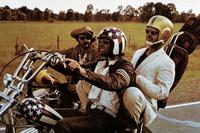Aging Motorcyclists Hit the Road, But at Greater Risk of Injury, Death
 |
ROCHESTER, NY - April 5, 2010: Motorcycle riders across the country are growing older, and the impact of this trend is evident in emergency rooms daily. Doctors are finding that these aging road warriors are more likely to be injured or die as a result of a motorcycle mishap compared to their younger counterparts.
While the typical injured motorcyclist has long been thought of as a young, otherwise healthy victim of sudden injury, a study from the University of Rochester Medical Center suggests otherwise. Between 1996 and 2005, researchers found the average age of motorcyclists involved in crashes increased from approximately 34 to 39 years, and the proportion of injured riders above the age of 40 increased from around 28 percent to close to 50 percent. Of all injured riders included in the study, 50- to 59-year-olds represented the fastest growing group, while 20- to 29-year-olds were the most rapidly declining.
"We made the clinical observation that older patients - people in their 50's, 60's and even 70's - were being injured on motorcycles with increasing frequency," said Mark Gestring, M.D., director of the trauma program at the University of Rochester Medical Center. "We wanted to see if this observation was true on a national level and we found that it was."
For riders above the age of 40, injury severity, length of stay in the hospital or intensive care unit, and mortality were higher compared to riders below the age of 40. The risk of dying was one-and-a-half to two times more likely in riders over 40, based on the severity of the original injury. The study also found that older riders are more likely to die from less severe injuries than younger riders, to spend at least 24 hours in the intensive care unit, and to have more pre-existing co-morbidities and complications, such as heart attack and infections, that contribute to longer hospital stays.
"Treating a 60-year-old who has been in a motorcycle accident is very different from treating a 21-year-old who has been in a similar accident - 60-year-olds bring a lot more medical baggage with them, and this can adversely impact outcomes following injury," said Gestring. "As people start to dust off their motorcycles this spring, older riders should take an extra measure of caution; if an accident happens they'll often pay a higher price than younger riders."
The increase in injury severity for older riders may be related to the reduced capacity to withstand injury as the body ages. Age-related changes, such as decreases in bone strength and brain size, may make older riders more susceptible to injury. Other factors associated with aging, such as impaired vision, delayed reaction time, and altered balance contribute to motorcycle crashes in this population, explaining in part the researchers' finding that older riders crashed more often as a result of loss of control than younger riders.
In the study, which was published in the March issue of the American Surgeon, researchers using the National Trauma Databank (www.facs.org/trauma/ntdb/index.html) reviewed the records of 61,689 motorcyclists aged 17 to 89 years involved in a motorcycle crash between 1996 and 2005. The average age of motorcyclists involved in crashes steadily increased over the study period, which is consistent with published statistics from the Motorcycle Industry Council which report that the average age of motorcycle ownership rose from 33 years in 1998 to 40 years in 2003.
Injury patterns remained stable over the study period, with extremity fractures, such as broken arms and legs, being the most common injuries, occurring in approximately 25 to 40 percent of motorcyclists studied. The majority of severe injuries were chest and head injuries, and researchers found significantly higher proportions of older riders sustained these types of injuries compared to younger riders.
The younger and older riders did have two things in common: helmet use and alcohol use. Overall helmet use was around 73 percent for both groups, and alcohol use was seen in approximately one third of injured motorcyclists, with no significant difference between the older and younger riders.
Alcohol use and helmet use have been linked in prior reports, with intoxicated drivers less likely to be wearing a helmet and therefore at greater risk for injury and death. It is not surprising that the researchers at the University of Rochester found that riders who tested positive for alcohol use were two-and-a-half times more likely to not be wearing a helmet at the time of injury. Despite abundant evidence that helmets reduce mortality, brain injury, length of hospital stay and economic burden, only 20 states have universal helmet laws.
Motorcycle crashes are a significant cause of injury and death on our nation's roadways, despite the fact that motorcycles are responsible for only a small fraction of the total miles traveled annually in the United States. The authors say that the study provides justification for expanding the scope of motorcycle safety research, education and training initiatives to specifically target the older motorcyclist.
"At the University of Rochester, we are looking at the development of prevention programs targeting motorcycle safety for older individuals, possibly in partnership with local motorcycle clubs and other interested groups," said Gestring.
One of the nation's top academic medical centers, the University of Rochester Medical Center forms the centerpiece of the University's health research, teaching, patient care, and community outreach missions. The Medical Center receives more than $240 million in external research funding per year and the University of Rochester School of Medicine and Dentistry ranks in the top one-quarter of U.S. medical centers in federal research funding. The University's health care delivery network is anchored by Strong Memorial Hospital - a 739-bed, University-owned teaching hospital. As upstate New York's premier health care delivery network, patients benefit from the Medical Center's robust teaching and biomedical research programs.


